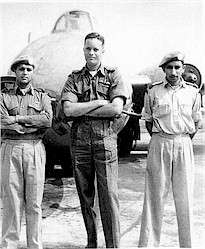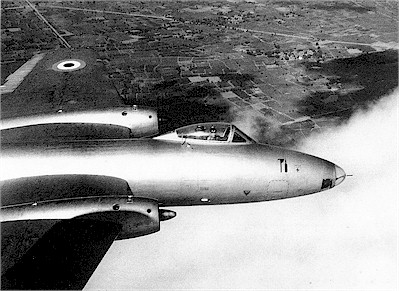K Sree Kumar writes about Air Commodore Peter Maynard Wilson PVSM, VrC and his initial stint flying Canberras in Congo in 1962
No 5 Squadron + Congo 1962.
Then a Flight Commander with No 5 Squadron, Squadron-Leader Peter Wilson was in the second IAF contingent to serve with ONUC, the UN force in the Congo. Some background, and the experiences of the first IAF contingent there, are set out in the article “Canberras in Congo” by Mr. Pushpindar Singh. Led by Wing Commander (later Air Commodore) AIK Suares, they served in the Congo from October 1961 till early 1962. During this period they carried out a highly effective air offensive against Katangan rebel airbases, took hostile fire, and earned a number of well-deserved decorations.
 |
Sqn Ldr PM Wilson in the Congo, with a Canberra unmistakably of the Tuskers. |
They were relieved in early 1962 by a contingent commanded by Wing Commander (later Air Marshal) Saroj Jena. This second contingent served in the Congo until October 1962. Wilson was modest as ever about his experiences there, saying that the first contingent had done all the operational work that needed to be done, by the time he got there. There may not have been much shooting in his time, but there were still some interesting stories …
No 5 Squadron Detachment, IAF, was based at Leopoldville (now Kinshasa), the capital of the vast, sprawling equatorial country. Officers were billeted in spacious colonial villas. The Leopoldville airfield had a 5,100 yard runway; the longest in the world at that time. Training was carried out there; operations were staged through Elizabethville (now Lubumbashi) or Kamina, over a thousand km east, and closer to the operational areas in the rebel province of Katanga.
It seems positively Dr Strangelove-esque now; but Kamina had actually been the designated alternative Belgian capital in case of nuclear war in Europe. Wilson remembers magnificent facilities, and a runway surface “like glass!” The base at Kamina was shared with other components of the multinational ONUC force, including detachments of Swedish Saab J-29s and Ethiopian F-86 Sabres. The base commander was Swedish, and the base was guarded by a Swedish security battalion.
Indian troops in the Congo received a UN allowance, reasonably generous but denominated in Congolese Francs. Swedish troops, in addition to their UN allowance, received a Swedish government supplement, of US$10 per day. As it happens, the Indians had no restrictions on purchasing liquor at the local PX. The Swedes were allowed to buy beer through the PX, but not hard liquor. The result, as Wilson describes it, was that “The Swedes had dollars and no whiskey; the Indians had whiskey and no dollars. The inevitable happened; there was supply and demand; market forces are too strong to resist.” Some IAF airmen proceeded to sell liquor to some of the Swedish troops, sometimes charging twice the PX rate.
| Left to Right: Flt Lt SL Dutta, Sqn Ldr PM Wilson, and Flt Lt Sachdeva, all of No 5 Sqn Detachment, in the Congo. |  |
Inevitably, there was an incident one day of drunken and disorderly behaviour on the part of the Swedish troops, which they blamed to their superiors on liquor sold to them by Indian airmen. The Swedish base commander rang Sqn Ldr Wilson, and demanded a line-up of the Indian airmen, for the Swedes to identify those who had been selling them the liquor. Sqn Ldr Wilson acceded politely to the identification request in principle, but asked that the mechanism be changed to a line-up of the Swedish troops, at which the IAF airmen would pick out those who had bought the liquor from them. After some huffing and puffing, no more was heard of the demand.
At Kamina, besides Swedish, Indian and Ethiopian aircrew, there was a solitary Norwegian helicopter pilot who seems to have been quite a character. He served two tours in the Congo, and received one of Norway’s highest gallantry decorations for his services there 1. In a practice reminiscent of that of Lieutenant (later Colonel) Gail Halvorsen, the USAF C-54 Berlin Airlift pilot variously known as the Candy Bomber and der Schokoladen Flieger, this Norwegian pilot often dropped packages of sweets to the Congolese villages he flew over. He referred to this as “My life insurance“. He was not particularly respectful of authority; when asked what his predominant memory of Africa was, his response was “Elephant arses“; a reference to the wildlife-viewing flights he was often asked to undertake, for visiting VIPs.
Operations.
IAF operations during Sqn Ldr Wilson’s tenure in the Congo consisted largely of road and airfield recce, and occasional photo recce over the rebel base at Kolwezi. This was not easy work. Outside towns and cities, the roads were poor, often barely track. Weather was unpredictable, and potentially lethal, with towering clouds and violent electric storms. In addition, there were no maps suitable for navigation. The Belgians only had road maps. The US had survey charts, which were accurate as far as they went, but were useless for map-reading.
When the IAF detachment went out to the Congo, there was “a universal assumption that we would be shot at”, Wilson says matter-of-factly. The official Congolese forces were themselves barely under control, quite apart from the Katangan rebels. As it turned out, the second IAF detachment never took rebel fire. But the Swedes did.
The Swedes employed Curtiss C-46 Commandos (some sub-contracted), as troop-carriers or freighters, to do regular runs between Kamina and Leopoldville, and back to Sweden, taking back personnel on rotation or leave, and bringing out fuel, “goodies” and occasional sight-seeing VIPs. One of these Commandos was shot down by rebels in the bush. The aircraft burned out, but there were several survivors. One party of survivors, led by a former Swedish Olympic athlete, set out from the site of the crash on foot, to try and find help. They were never seen again.
The site of the crash was found, and a UN helicopter operation was mounted to rescue survivors who had chosen to stay by the wreckage, rather than set out on foot. Sqn Ldr Wilson was tasked to provide cover for this operation. He went in first, before the helicopter, and reconnoitered the location. There were no rebel forces visible, so he called in the chopper. As it approached to land, “about 50 or 60 people” broke from cover and ran towards it. In front were the Swedes, visibly European even from Wilson’s altitude; but they were being either followed, or chased, by a number of identifiable Africans. Wilson did not want to fire, as it was not clear if the Africans were hostile, and they were anyway too close to the Swedes; but to warn them off he made several low passes over them; low enough so that they threw themselves to the ground as he passed over. The helicopter pilot called Wilson on the R/T, “IAF Canberra please stop, you are frightening these people!” The Africans turned out to be friendly local Congolese, who had helped and looked after the Swedish survivors, rather than hostile Katangan rebels.
Departure.
On the IAF detachment’s departure from the Congo, four crews, including Sqn Ldr Wilson, were detailed to ferry the remaining IAF Canberras back. The other aircrew, and the groundcrew, were to return by regular scheduled airline flights. They were restricted to the airlines’ usual 20 kg luggage allowance. Sqn Ldr Wilson gave instructions that all members of the detachment were free to give any extra luggage they wanted taken back to India, to the ferry crews, who would bring them back as cargo packed into the Canberras’ bomb-bays.
| Sqn Ldr PM Wilson in the cockpit of a Canberra homeward bound. |  |
On their departure from Leopoldville, the Canberras were distinctly overloaded. However as the runway was so long, they managed to get into the air. They staged through Nairobi, where they were refuelled and serviced by an RAF detachment. One of the RAF fitters opened a hatch he shouldn’t have, and is said to have been awestruck: “Look at this loot!” On leaving Nairobi, which had a shorter runway and is at a higher altitude (over 4,000 ft) than Leopoldville, the Canberras are said to have taken a rather long run to get airborne.
Notes:
1. Wilson cannot recall this pilot’s name, but it may have been Lieutenant Per Bøe Karlsen, who was invested with Knighthood of the Royal Norwegian Order of St Olav, for a daring rescue of a group of priests and nuns.
Rest of the Article Continued Here